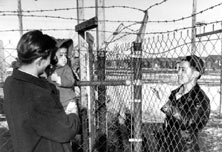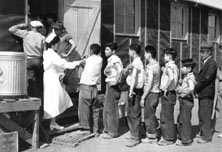Historic time period: 1929–1945
More Information

Boy behind barbed wire fence, Tule Lake.
Copyright © 2002 Smithsonian National Museum of American History | Photograph by Jack Iwata, courtesy of the National Archives.
View largerDaily Life in the Internment Camps
Life was challenging for Japanese Americans living inside the internment camps.
Read the quotes below and look at the photographs to learn more about what daily life was like in the camps.
"We saw all these people behind the fence, looking out, hanging onto the wire, and looking out because they were anxious to know who was coming in. But I will never forget the shocking feeling that human beings were behind this fence like animals [crying]. And we were going to also lose our freedom and walk inside of that gate and find ourselves…cooped up there…when the gates were shut, we knew that we had lost something that was very precious; that we were no longer free."
Mary Tsukamoto

New arrivals waiting to be vaccinated.
Copyright © 2002 Smithsonian National Museum of American History | Photograph by Clem Albers, courtesy of the National Archives.
View largerImagine what it would be like if you and your family had to leave your home and live in a camp behind a barbed wire fence. Make a list of all of the activities you enjoy now that you would have to give up, like going to the movies or playing at a friend's house. How would you feel?
Look at the pictures of the children standing in line. What are they waiting for?
Children and adults had to stand in line for many things, including eating and going to the bathroom. How do you feel when you have to wait in a long line at the movies or at an amusement park?
How would you feel if you had to wait in long lines for everything you did? Why?

Boys playing baseball in a huddle.
Copyright © 2002 Smithsonian National Museum of American History | Photograph by Dorothea Lange, courtesy of the National Archives.
View largerIn the book Baseball Saved Us, a boy named Shorty and his father create a baseball diamond so that children in the camp can play.
Look at the boys in the picture. What do you think they are saying to one another?
Being able to play baseball and other sports was important to children in the camps. Why do you think it was important to them? How would you feel if you had to give up playing your favorite sport?
After the Internment Camps
"Not only was the evacuation wrong, but Japanese Americans were and are loyal Americans."
President Gerald R. Ford
How do you feel about the way Japanese Americans were treated during WWII?
In 1988, many years after WWII, a Federal Commission's findings convinced Congress that the internment camps were wrong, and the United States Government should accept responsibility. The government apologized, and passed the Civil Liberties Act of 1988 that acknowledged that a "grave injustice was done." The government also promised to repay Japanese Americans for the losses they suffered. Today, the Japanese American community is still working to make sure that all those who were forced to leave their homes are compensated.
What do people today think about the internment camps?
You and your family can learn more about the internment of Japanese Americans by visiting these websites:
-
A More Perfect Union: Japanese Americans and the U.S. Constitution
Search more than 800 artifacts from the Smithsonian collections by visiting this virtual exhibition by the National Museum of American History, Behring Center. The exhibit tells the story of Japanese American internment through interactive galleries that combine images, music, text, and first-person accounts. -
Dear Miss Breed: Letters from Camp…
The Japanese American National Museum features this virtual exhibition that explores letters written by children in the internment camps to a public librarian, Clara Breed. These letters tell the story of internment through the eyes of the incarcerated children, and show how one woman's compassion touched the lives of many people. -
Children of the Camps: The Documentary
This PBS documentary tells the stories of six Japanese Americans who were interned during WWII, and explores the lasting effects of their experiences.


